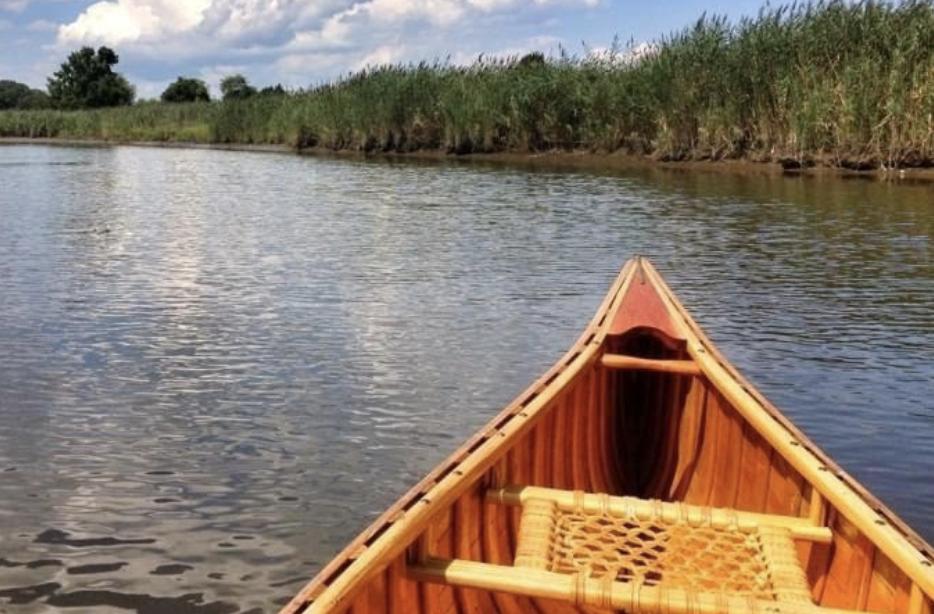Jack Hurley, a Buffalo native, moved to Canada many years ago to build canoes. He settled n Dwight, Ontario, a dot on the map not far from the western portal of the Algonquin National Park, a wilderness area of nearly 3,000 square miles. There are more bear, moose, beaver, and loons than people in the park which is iced in for at least five months every year. There is but one road through the park; otherwise travel is on foot or by canoe along the Oxtongue River or through a series of pristine lakes connected haphazardly by portage trails. There are campsites throughout the park, but a paddler can go for days without seeing another human being. Jack loved it.
I was introduced to Jack by one of my oldest and dearest friends who was the proud owner of one of Jack’s canvas and cedar-strip canoes. I was living in Washington at the time and didn’t have much use for a fine canoe, but Jack’s craftsmanship was so overwhelming that I decided to purchase one. We agreed on a design: Jack’s interpretation of a Bobs Special, a fifteen-plus foot, keeled canoe named for Lord Frederick Roberts (his nickname was Bobs), a beloved senior commander in the South African Boer Wars. The first Bobs Special was built early in the 20th Century and over the years, the design has changed very little. It’s a versatile craft, paddled easily by one but plenty comfortable for two. I wanted mine painted cardinal red.
It would take Jack a year to build my canoe. Or so he said. I imagine what really happened in the twelve intervening months from the day Jack and I shook hands until the day I returned to Dwight was that with about two months to go, Jack and his “team,” a lovely young female apprentice, went into overdrive to construct my boat.
Jack is a master builder but building a canvas and cedar canoe is more an act of love or work of art than a construction project. The technique is centuries old and involves clenching thin cedar ribs to a steamed frame, then covering the hull with a drum-tight canvas skin. While the hull cured, Jack worked on the thwarts and gunwales, made of ash and also steam-bent. We had decided on gut seats, more comfortable and durable than traditional cane. As a gift, Jack fashioned a yoke crafted of cherry to mine for easier carrying. Finally, several coats of bright red marine paint were applied to the hull, sealing and weatherizing it. It was deemed dry and lake-worthy a day or two before I arrived back in Dwight in the summer of 2005.
I’ll never forget the first time I saw my canoe. It glistened, redder-than-red, varnished inside to a high gloss that took my breath away. I couldn’t wait to take it on the lake, and when I did, it was everything I had hoped for and more. It tracked well and whether in the pre-dawn stillness or under a canopy of stars, I felt one with the water around me. I named my canoe Arcturus after one of the brightest stars visible from the Northern Hemisphere.
I was careful that summer and learned the whereabouts of every underwater rock that might scrape a bit of paint off hull—or worse. Our camp sits comfortably on a lake that’s three miles long and a mile wide and every day, I paddled in and out of quiet coves and through lily pads covered with bright lotus blossoms. I watched beavers building a dam, sat quietly while the loons fished and talked to each other, even paddled gently behind a deer swimming across the lake at sunset. Arcturus took me everywhere, silently, secretly. At a store in Huntsville, the only town of any size for miles around, I bought a thwart bag and a red woolen toque and imagined myself one of those old Canadian voyageurs with a canoe full of pelts to trade for whiskey.
When it came time to pack up and make the long drive home, I secured Arcturus to the top of the car, packed up my gear, and headed south. Four hours later, I crossed the border at the Peace Bridge and once across the Niagara River, I found my way onto the New York State Thruway heading west. If all went well, Arcturus and I be home in about eight hours.
If. Such a small, little word…
I’ll be right back.
Jamie Kirkpatrick is a writer and photographer with a home in Chestertown. His work has appeared in the Washington Post, the Baltimore Sun, the Philadelphia Inquirer, the Pittsburgh Post-Gazette, the Washington College Alumni Magazine, and American Cowboy Magazine. Two collections of his essays (“Musing Right Along” and “I’ll Be Right Back”) are available on Amazon. Jamie’s website is www.musingjamie.com




Deirdre LaMotte says
Enjoyed this piece. This is not far from our camp and also where we had a wooden boat built.
Jenifer Emley says
G a s p ! I can’t wait to know what happened. Hurry back!